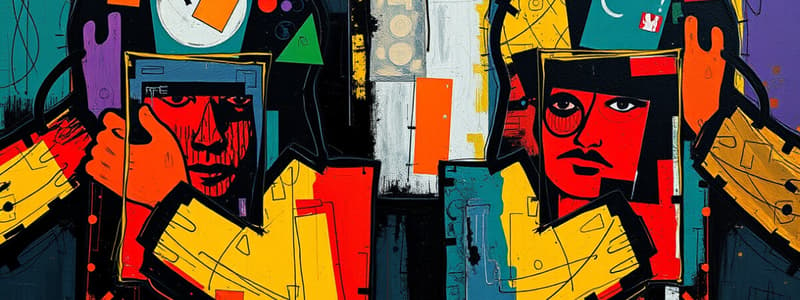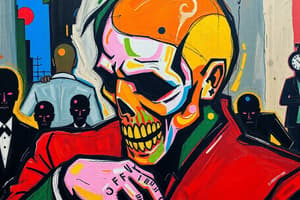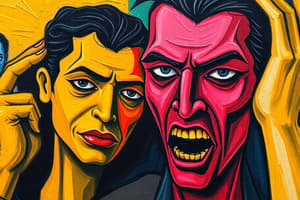Podcast
Questions and Answers
What is deviance?
What is deviance?
Modes of action that do not conform to the norms and values accepted by a significant number of people in society.
What are the three parameters to recognize crime?
What are the three parameters to recognize crime?
Time, Place, and public consensus.
What is criminal deviance and some examples?
What is criminal deviance and some examples?
Involves violating a criminal law and away from social norms. Examples include homicide, rape, robbery, and gambling.
What is non-criminal deviance and some examples?
What is non-criminal deviance and some examples?
Who linked physical characteristics to crime?
Who linked physical characteristics to crime?
Who viewed muscular types as biological deviance?
Who viewed muscular types as biological deviance?
Biological and Psychological views located deviance in the ______ while sociological locate deviance in the ____.
Biological and Psychological views located deviance in the ______ while sociological locate deviance in the ____.
What was Emile Durkheim's functionalist theory?
What was Emile Durkheim's functionalist theory?
What is Robert Merton's strain theory?
What is Robert Merton's strain theory?
What is the focus of functionalist theories about deviance?
What is the focus of functionalist theories about deviance?
What is Albert Cohen's functionalist theory?
What is Albert Cohen's functionalist theory?
What is R. Cloward and L. Ohlin's functionalist theory of crime?
What is R. Cloward and L. Ohlin's functionalist theory of crime?
What is the focus of reinforcement theories?
What is the focus of reinforcement theories?
Who invented the differential association theory and what is it?
Who invented the differential association theory and what is it?
What is Travis Hirschi's control theory?
What is Travis Hirschi's control theory?
What is the focus of symbolic interactions?
What is the focus of symbolic interactions?
What is the Labeling theory and who discovered it?
What is the Labeling theory and who discovered it?
What is primary and secondary deviation?
What is primary and secondary deviation?
What is the focus of conflict theories?
What is the focus of conflict theories?
What was the conflict theory for William Chambliss?
What was the conflict theory for William Chambliss?
What was the conflict theory for Richard Quinney?
What was the conflict theory for Richard Quinney?
What is the conflict theory for Marxists?
What is the conflict theory for Marxists?
What is a white-collar crime?
What is a white-collar crime?
Who coined the term 'White Collar Crime'?
Who coined the term 'White Collar Crime'?
What is corporate crime?
What is corporate crime?
What are some examples of corporate crimes?
What are some examples of corporate crimes?
Who coined the term 'Organized Crime'?
Who coined the term 'Organized Crime'?
Flashcards are hidden until you start studying
Study Notes
Understanding Deviance
- Deviance refers to actions that do not conform to societal norms and values, including any act that violates established norms.
- Key parameters for recognizing crime include time, place, and public consensus.
Types of Deviance
- Criminal deviance involves violations of criminal law and social norms, such as homicide, rape, robbery, and gambling.
- Non-criminal deviance consists of actions that stray from social norms, including the use of pornography, mental illness, and binge drinking.
Theoretical Perspectives on Deviance
- Cesare Lombroso linked physical characteristics, particularly skull shape, to criminality.
- William Sheldon associated certain body types with biological deviance.
Biological vs. Sociological Views
- Biological and psychological perspectives locate deviance within the individual, whereas sociological views find it in societal acts.
Emile Durkheim's Functionalist Theory
- Durkheim proposed that deviance benefits society by enhancing conformity, fostering social solidarity, safely releasing societal discontent, and encouraging social change.
Robert Merton's Strain Theory
- Merton's strain theory suggests that deviance arises when society emphasizes success without providing equal opportunities for achievement.
Function of Structural Tensions
- Functionalist theories emphasize that crime and deviance are produced by structural tensions and a lack of moral regulation in society.
Albert Cohen's Subculture Theory
- Cohen argues that societal contradictions lead to crime occurring through the development of subcultures.
R. Cloward and L. Ohlin's Theory
- This theory focuses on subcultural communities where opportunities for legitimate success are scarce, contributing to deviance.
Reinforcement Theories
- Reinforcement theories highlight deviance as influenced by rewards and punishments, learned from significant others.
Differential Association Theory
- Edwin H. Sutherland introduced this theory, which posits that deviance arises from associations with groups that promote pro or anti-deviant definitions.
Travis Hirschi's Control Theory
- Hirschi's control theory explains that crime results from an imbalance between impulses to commit criminal acts and societal controls against them.
Symbolic Interactionism
- Symbolic interactionists view deviance as a socially constructed phenomenon, emphasizing the meanings behind deviant behavior.
Labeling Theory
- Howard S. Becker formulated the labeling theory, which asserts that being labeled as deviant leads individuals to internalize that label and act accordingly.
- Primary deviation refers to the initial act of wrongdoing; secondary deviation occurs when the individual accepts the label and identifies as deviant.
Conflict Theories of Deviance
- Conflict theories analyze crime and deviance through the lens of societal structure, highlighting competing interests among social groups and the dynamics of power and inequality.
William Chambliss' Conflict Theory
- Chambliss proposed that law enforcement tends to favor the interests of the wealthy and powerful over those of the poor.
Richard Quinney's Perspective
- Quinney argued that the dominant class creates deviance by crafting laws that oppress the subordinate class while promoting crime ideologies.
Marxist View on Deviance
- Marxist theories contend that deviance is rooted in the exploitative nature of capitalism.
White Collar and Corporate Crime
- White collar crime refers to criminal acts conducted by individuals in professional roles, a term coined by Edwin Sutherland.
- Corporate crime encompasses offenses committed by large corporations, with examples including Enron, Martha Stewart, and Global Communications.
- The term "organized crime" was coined by Manuel Castells.
Studying That Suits You
Use AI to generate personalized quizzes and flashcards to suit your learning preferences.




